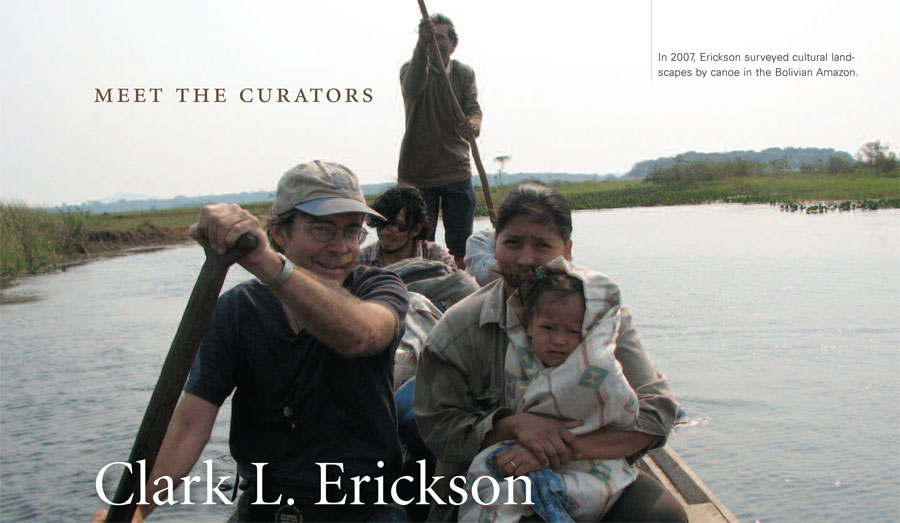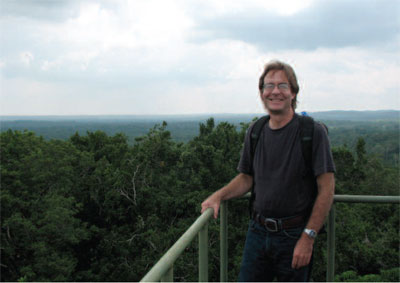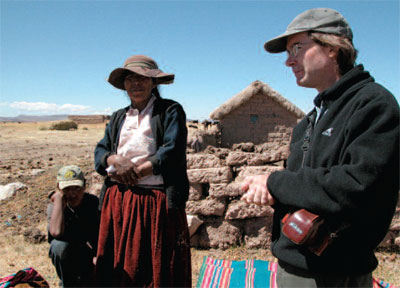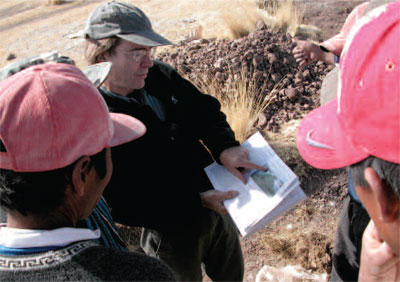
Growing up surrounded by his mother’s books and framed travel photos of archaeological sites and places such as Lebanon, Egypt, and Saudi Arabia, Clark L. Erickson, Associate Curator in the Museum’s American Section, developed an early interest in the study of the past. Since then, Erickson has dedicated his career to “peopling the past” by understanding the decisions and choices people made and how these affected and shaped the natural and cultural landscapes in which they lived. By “reading” the often complex layering of landscape features and patterns, archaeologists are developing new ways to understand the lives of common people in the past.
As an undergraduate, Erickson attended Washington University in St. Louis from 1972 to 1976. An early fortuitous meeting with archaeologist Patty Jo Watson led Erickson to accompany several graduate students to the famous Mississippian period (AD 800–1500) earthen mound site of Cahokia a few miles east of St. Louis in southern Illinois. Impressed by this visit, Erickson would go on to assist Watson in her analysis of archaeological work undertaken at a number of sites in the United States—Cibola, New Mexico, the Green River Archaic shell middens of Kentucky, and Salts Cave, Kentucky.



Originally intending to focus on the prehistoric archaeology of the American Southeast, Erickson changed his plans during a junior-year fieldwork trip to South America with David Browman. The experience of surveying, excavating, and coordinating botanical research at the Bolivian site of Chiripa—an early farming village—while living in an adobe hut in a small rural community for two-and-a-half months, convinced Erickson that South American archaeology was his real passion.
In 1976, after completing his undergraduate degree and a senior thesis on the plant remains from Chiripa, Erickson began his graduate studies in the large Department of Anthropology at the University of Illinois in Urbana-Champaign. Although initially interested in pursuing research in Bolivia, political events necessitated a shift to Lake Titicaca in the Peruvian Andes.
With dissertation funding from the National Science Foundation, Erickson and his anthropologist wife Kay spent three-and-a-half years living in a small Quechua community. There he studied contemporary Andean farming, while examining long-abandoned, pre-Columbian raised field systems— relatively long and narrow agricultural plots created in seasonally inundated wetlands by piling earth in a manner that drained the fields and allowed water to collect in the intervening ditches. As part of his research, he conducted agricultural experiments that focused on reestablishing the use of these pre-Columbian raised fields. Using indigenous knowledge in combination with archaeology, he established models for sustainable and appropriate technology, thereby making raised fields once again relevant to the contemporary world—an example of applied archaeology. By 1986, the indigenous farmers working with Erickson had 10 hectares (24.7 acres) of raised fields in use.
Upon completion of his Ph.D. in 1988, Erickson came to the University of Pennsylvania as Assistant Professor of Anthropology and Assistant Curator in the Penn Museum’s American Section. In 1996, Penn appointed him Associate Professor and Associate Curator.
Since 1990, Erickson’s primary research has focused on the Bolivian Amazon, where his multidisciplinary team investigates pre-Columbian agriculture. Specifically, he has drawn attention to raised fields and their associated earthworks and how they form sophisticated hydraulic and engineering works. For example, since 1995, his Bolivian Amazon project has investigated an enormous complex of pre-Columbian earthworks in the Baures region. By analyzing satellite imagery, photographs from small planes, and archaeological survey and excavation data, Erickson has identified numerous landscape features, such as moat or ditch earthwork enclosures, canals, raised causeways, fields, fish weirs, and settlements. In particular, his research on the canals and earthen causeways that connect the “forest islands” in this vast area are helping us better understand the networks that connected humans to one another, as well as the organization, engineering, and technological knowledge required to build these pre-Columbian earthworks and the permanent impact that pre-Columbian peoples had on their landscape and environment.
This research has led to Erickson’s recent interest in historical ecology—a theoretical approach that considers how humans have transformed and engineered their landscape by creating new diverse habitats through such disturbances as the systemic and selective burning of vegetation and the building of canals, raised roads, fish weirs, and reservoirs. Archaeology’s long view of ecology focuses on the human history of the environment and how it shapes biodiversity. This can, in turn, contribute to ecological conservation and management. Erickson’s recent edited volume, Time and Complexity in Historical Ecology (Columbia University Press, 2006) explores these themes in detail.
Erickson looks forward to many years of research with his Bolivian and other international colleagues, and to how their project results will inform knowledge about biodiversity and sustainable management of resources in the modern world.
